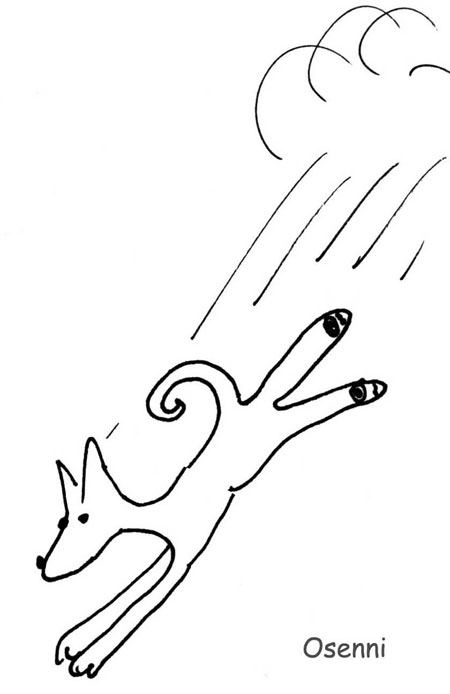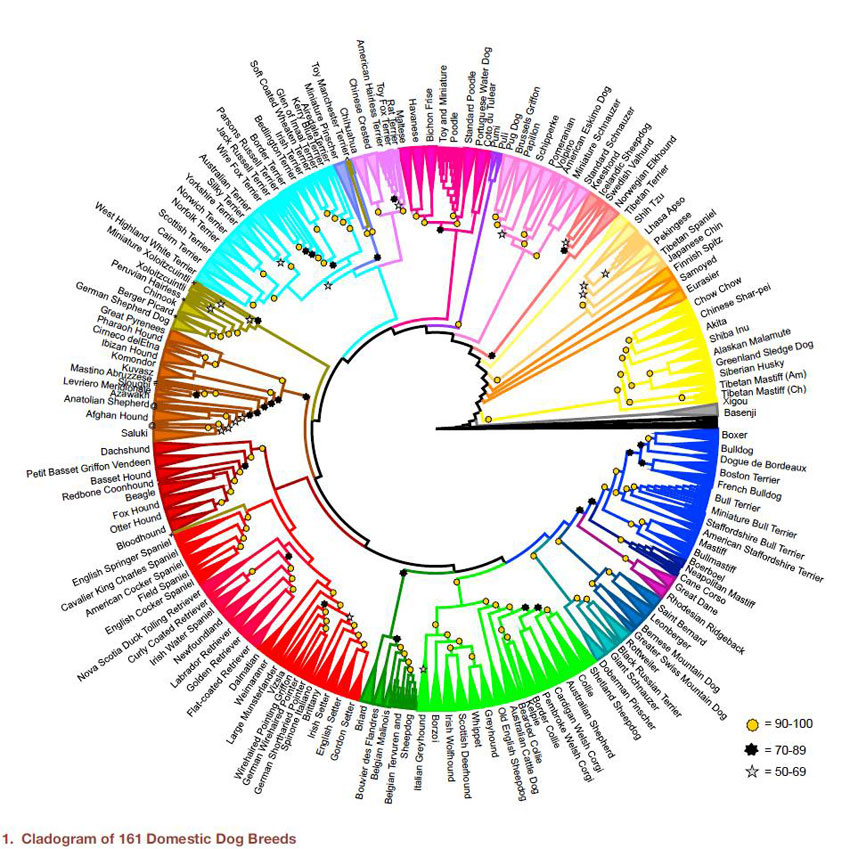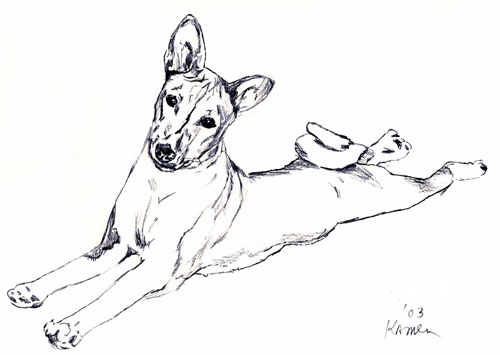Page 12 <previous page > <next page>
SOME HEALTH & SCIENCE NEWS

1. Genomic Analyses Reveal the Influence of Geographic Origin, Migration,
and Hybridization on Modern Dog Breed Development
2. Eating grass
3. Hypothyroidism in Basenjis.
 Tick Prevention: {Ed. I use Frontline topically once a month. I feel it is may be a tad more viable on our short haired dogs than some others, as application is easier. There is some thought that amber bead necklaces may help prevent ticks. I would use those in addition to Frontline. Dr. Dodds says use Frontline, but be careful in households with cats. I, myself haven't a comfortable feeling about putting tick tubes in my backyard.}
Tick Prevention: {Ed. I use Frontline topically once a month. I feel it is may be a tad more viable on our short haired dogs than some others, as application is easier. There is some thought that amber bead necklaces may help prevent ticks. I would use those in addition to Frontline. Dr. Dodds says use Frontline, but be careful in households with cats. I, myself haven't a comfortable feeling about putting tick tubes in my backyard.}
Shared by Bob Kamen:
"Interesting. Basenjis aren't related to any other breed group it would seem."
Genomic Analyses Reveal the Influence of Geographic Origin, Migration,
and Hybridization on Modern Dog Breed Development
Authors: Heidi G. Parker, Dayna L. Dreger, Maud Rimbault, Brian W. Davis, Alexandra B. Mullen, Gretchen Carpintero-Ramirez, Elaine A. Ostrander.
Highlights
•Neighbor joining cladogram of 161 breeds establishes 23 supported clades
•Crossing between diverse clades was done recently to add new traits
•Migration of a breed to a new region alters both immigrant and indigenous breeds
•Tracking recent crosses can identify the source of mutations in multiple breeds
Summary
There are nearly 400 modern domestic dog breeds with a unique histories and genetic profiles. To track the genetic signatures of breed development, we have assembled the most diverse dataset of dog breeds, reflecting their extensive phenotypic variation and heritage. Combining genetic distance, migration, and genome-wide haplotype sharing analyses, we uncover geographic patterns of development and independent origins of common traits. Our analyses reveal the hybrid history of breeds and elucidate the effects of immigration, revealing for the first time a suggestion of New World dog within some modern breeds. Finally, we used cladistics and haplotype sharing to show that some common traits have arisen more than once in the history of the dog. These analyses characterize the complexities of breed development, resolving longstanding questions regarding individual breed origination, the effect of migration on geographically distinct breeds, and, by inference, transfer of trait and disease alleles among dog breeds.
Source
Cell Reports - Apr 25, 2017
19|4|Pages 697-708
DOI: 10.1016/j.celrep.2017.03.079
DOI: http://dx.doi.org/10.1016/j.celrep.2017.03.079
April 25, 2017 | Volume 19 | Issue 4
EATING GRASS

“Why do dogs eat grass?” My veterinary colleagues and I are asked this frequently and we honestly do not know the exact reason or reasons. To try to answer this age old question, a few studies have been conducted.
Researchers at the University of New England in Australia compared two sets of dogs. One set of dogs was given a diet supplemented with fructo-oligosaccharide (FOS), which temporarily can induce loose stools and mild gastrointestinal (GI) distress. The researchers observed that the group not fed the FOS diet and with normal stools actually ate grass for longer periods of time. In this particular instance, the team determined that dogs apparently do not eat grass to self-medicate for this form of GI distress. They were quick to note, however, that grass eating may occur for self-medicinal purposes for other types of potential GI disturbance episodes. Importantly, this team of researchers only observed two vomiting episodes after grass eating, which led them to conclude that dogs do not eat grass to induce vomiting.
Another team of researchers at the University of California, Davis conducted three separate surveys. Their hypothesis was, “Most plant eating in dogs is associated with illness or a dietary deficiency and that ingestion of plant material is usually followed within a few minutes by vomiting.” for more: Why do dogs eat grass?
It is foolish to breed a dog or bitch without a complete thyroid panel in the anestrus before the breeding.
STILL AND ALWAYS OF INTEREST
An OFTEN published article on hypothyroidism.

Hypothyroidism
in Basenji Dogs
by Karen P. Christensen
Since my own dog. Selket, was diagnosed with hypothyroidism (HT), I have had some time to research the symptoms of the disease. I have become something of a crusader, suggesting thyroid testing to dog owners for symptoms ranging from weight gain to seizures to infertility: the overweight, 4 year-old golden retriever (HT is very common in Goldens) at the kennel, who was having seizures; a friend whose year-old basenji is losing the fur from her puppy buns; the woman in the dog park with the greyhound (another high-HT breed) whose skin was callused, greasy and smelly, like Selket's; the couple at the vet whose 2 year-old lab is so overweight you could serve dinner on his back....
The reasons for this are simple:
The literature indicates that Hypothroidism is the most common endocrine disorder in dogs, and we know, for people, Synthroid is the third most used pharmaceutical in the USA. All of the above symptoms can be related to hypothyroidism.Using the proper tests, HT is relatively easy and inexpensive to diagnose. HT is extremely easy to treat with daily replacement therapy; and Treatment makes such a huge difference in the quality of life for the dog and therefore for its owner.
The case for regular thyroid screening for all dogs is easy to make. While treating a HT dog is not difficult, it is not a characteristic anyone would want to encourage in breeding, and which needs to be understood in breeding stock. Hypothyroidism in basenjis has shown up in dogs as young as 12 months old.
A lack of thyroid hormone can cause a vast array of symptoms that are also common to other illnesses. Thyroid screening can thus be used to rule out hypothyroidism as the cause of some symptoms, as well as ruling it in. Many of the conditions, such as weight gain, lethargy, and joint problems, when seen in older dogs, are considered unavoidable symptoms of age. I considered Selket an old dog at 8 years, due to her lack of energy, thick skin, and lameness in her shoulder; at 11 years, I do not consider her old at all as I watch her romp with a much younger dog. The difference has been the diagnosis and treatment of hypothyroidism.
The reason for the symptoms is that thyroid hormones control metabolism of fats, carbo-hydrates and lipids; energy transfer; and cell maturation. This last is the cause of poorskin/coat quality, joint problems (cartilage does not regrow fast enough to replace what is worn off), and sterility (sperm and eggs do not mature.) Because lipids are not metabolized, a hypothyroid dog may have high cholesterol, which can cause seizures and heart problems due to plaques in the coronary arteries (atherosclerosis, the same cause of heart disease as in humans), as well as strokes.
The thyroid hormones regulate metabolism.
The high cholesterol that accompanies hypothyroidism (too little thyroid hormone) can, however, lead to atherosclerosis and strokes in dogs.
Thyroid function tests are affected by many things, including stress and medications. Several recent studies have demonstrated that phenobarbital therapy causes falsely low values on some thyroid tests. Recent seizures will also cause false lowering of the values, presumably due to the stress they cause. So test results need to be interpreted with these caveats in mind. If an animal tests truly low on thyroid function, then a trial of thyroid supplementation is indicated.
The blood serum sample from a hypothyroid dog may look like a strawberry milkshake - cloudy, thick, and bright pink. This is from the lipemia/high cholesterol and from hemolysis. I was pretty shocked and upset when I saw this in Selket's second sample (after a month on a low dose of levothyroxin, the synthetic thyroid replacement normally prescribed), since I expected a clear, pale yellow liquid. When I spoke to Dr Dodds (see below) she said this was a strong indication of hypothyroidism (which makes me wonder why we even had the sample analyzed instead of just upping the dose). Literature indicates the presence of high cholesterol makes measurement of one form of thyroid, T3, inaccurate for diagnosing hypothyroidism.
Monitoring your dogs:
Of course it is preferable to diagnose hypothyroidism before the dog becomes ill. Since it is relatively common in basenjis, it is not unreasonable to begin annual testing, as Wellness Care, after puberty. Testing must be done in anestrus, which means count 100 days from the first day of the heat cycle.
By the way, you should do the same for male dogs who are around bitches in season.
It is very important to have the right thyroid tests done.
I use Dr. Dodds (Hemopet Thyroid Testing) because she gives her opinion along with the test results. Since Hemopet is Not-for-Profit, the fee is quite reasonable. You can choose to have a complete panel + the OFA panel done. Jean knows the correct levels for basenjis, which she says is different from other sighthounds and other breeds.
And you can talk to her. You SHOULD talk to her, if you suspect your dog is hypothyroid, if you have results from a different lab, or if your vet gives you a hard time. Email her or give call her at Hemopet.
Total T4 or T3 measurement alone, or T3 & T4 alone, are not accurate for diagnosing HT. You need to have results for T3, T4, Free T3, Free T4, and TgAA. TSH levels are not particularly useful (65% predictive in canines).
Dr. Dodds will do an OFA thyroid panel that includes TSH, but she also includes all of the other levels; not just two more.
Treating the hypothyroid dog is inexpensive and easy. They simply get a small pill twice a day of levothyroxine (T4 - Thyro-Tabs).
The pill should be given 1 hour before or 3 hours after meals, and not in milk products.
Peanut butter or steamed yams work fine to hide the tiny pills.
Finally, I have heard of some people who are reluctant to use thyroid replacement because it is synthetic, because it is a pharmaceutical, a drug. Well, it is a chemical the dog normally has. There is no herbal equivalent for synthetic levothyroxine. The synthetic drug contains only the T4 and no other biologically active molecules.
As for the drug companies possibly making money off of us, I'd say they make their profit based on the huge amount that's sold, because the per-dose cost is so low, it cannot be much more than it costs them to manufacture and distribute it.
Here is a list of symptoms of hypothyroidism (that improve when T4 therapy is given); one or more other diseases or conditions could also cause most of them but HT is such a common condition, and is inexpensive and easy enough to test for.
Lethargy,
Mood swings,
Aggression,
Loss of energy,
Vestibular (ear) disease,
Poor coat, scaly skin,
Hypo pigmentation,
Body odor,
Skin lesions,
Weight gain,
Weight loss, picky eater,
Seizures,
Sterility,
Testicular atrophy,
Aspermia,
Absence of heat cycles,
Too many heat cycles,
Prolonged interestrus,
Pseudopregnancy,
Reproductive failure,
Re-absorption of fetus,
Joint problems,
Slow heart rate,
Stiff or slow movement,
Dragging front feet,
Head tilt,
Tragic expression/facial paralysis,
Balance problems,
Frequent vomiting,
Diarrhea,
Cardio-myopathy,
Megaesophagus,
Ruptured knee ligaments,
Corneal ulcers,
Dry eye syndrome,
High cholesterol,
Atherosclerosis,
Cold intolerance,
Heat intolerance,
Exercise intolerance,
Chronic infections,
Anemia,
Low white blood cell count,
Bone marrow failure,
Chronic hepatitis, etc.

